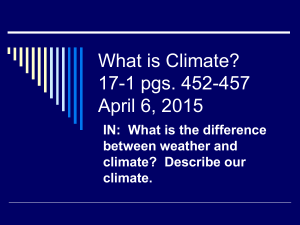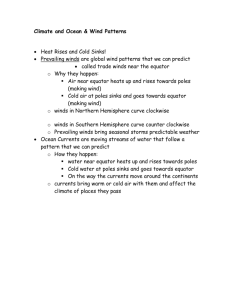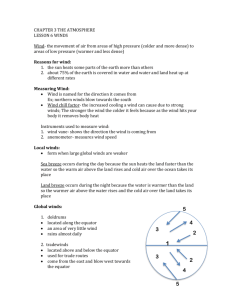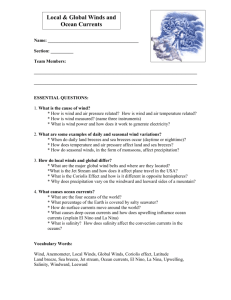Physical Geography
advertisement
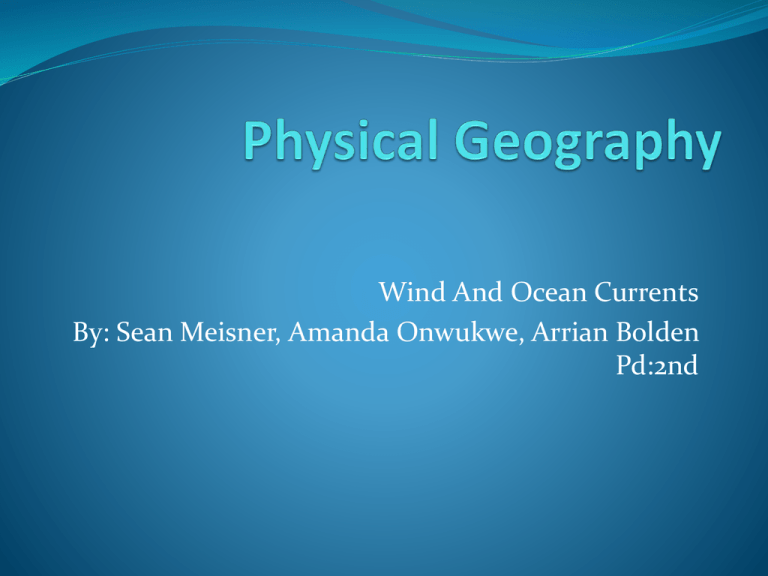
Wind And Ocean Currents By: Sean Meisner, Amanda Onwukwe, Arrian Bolden Pd:2nd What Is Wind? Wind: Is air moving across the surface of the Earth Wind occurs because sunlight heats the earth’s atmosphere and surface unevenly. How Does It Affect Weather? Warm temperature causes air to rise, which creates areas of low pressure (Mountains) Cool temperatures cause air to sink, which creates areas of high pressure. (Oceans) How Does It Affect Weather Cont. Wind & water work together to affect weather in an important way. One way is Condensation, (caused by temperature) which creates precipitation that then creates many different types of weather’s like rain, sleet, hail, or snow. One big factor is called the El Nino phenomenon. https://www.youtube.com/watch?feature=player_ detailpage&v=WPA-KpldDVc El Nino – What Is It? (Met Office) Ocean Currents Ocean currents are caused be wind moving across the surface of the sea. Ocean currents as well as wind distribute the sun’s energy around the earth Ocean Currents Cont. Cold ocean currents travel toward the equator and warm ocean currents travel toward the polar regions Prevailing Winds Is what you call winds blowing because of pressure differences; (warm air moving towards the poles and cool air moving to the equator) which creates winds that blow in a semi-constant patterns. *The direction of these winds depend on the earth’s movement & latitude Coriolis Effect This effect causes prevailing winds to blow diagonally across the earth. This means that as the earth rotates, prevailing winds blowing in the Northern Hemisphere are deflected to the right and to the left in the Southern Hemisphere. What Are Winds Called? Trade Winds: Named for their ability to move trade ships, trade winds blow northeast toward the equator (latitude 30 degrees north) and southeast toward the equator (latitude 30 degrees south) Westerlies: Are prevailing winds blowing diagonally east to west between 30N,60N and 30S and 60S Polar Easterlies: Blow diagonally east to west, pushing cold air towards the midlatitudes Doldrums Near the equator the Trade Winds subside as the warm air rises. The rising leaves a narrow, windless band called the doldrums. Wind in Relation to Landforms Windward: When the landform is facing the direction the wind is blowing. (cooler, wetter side) Leeward: When the landform is facing away from the direction of the wind. (warmer, drier side) Rain Shadow: When hot, dry air makes no precipitation which causes dry areas or even deserts to form on the leeward sides of mountains Picture URL’s http://www.sturdyforcommonthings.com/wp content/uploads/2013/03/wind_blowing.jpg http://www.geography4kids.com/files/art/atm_circ2_240x180.gi f hhttp://www.myfreetextures.com/wpcontent/uploads/2014/11/blue-ocean-waves.jpg ttp://www.srh.noaa.gov/jetstream/ocean/images/basiccurrents.j pg https://geogermanykat.files.wordpress.com/2014/10/wor_them_ winds.jpg http://images.flatworldknowledge.com/wrench/wrenchfig15_001.jpg https://upload.wikimedia.org/wikipedia/commons/thumb/f/fa/ Rain_shadow_no_text.svg/500px-Rain_shadow_no_text.svg.png



